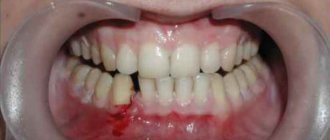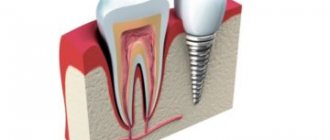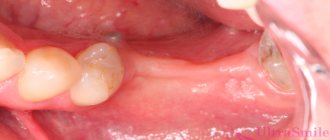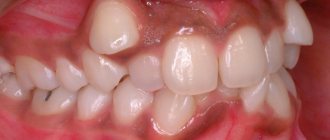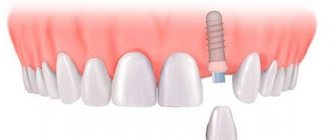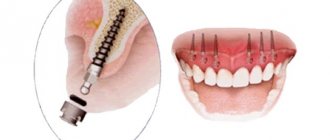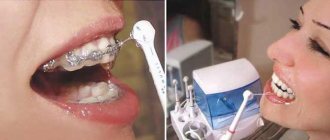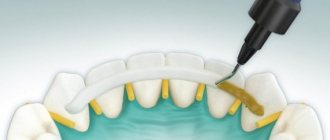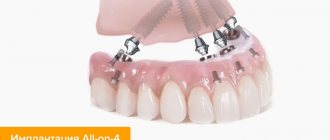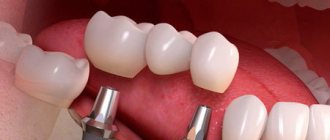Placement of artificial teeth in partial removable laminar dentures
Artificial teeth on the basis of a prosthesis can be placed in two ways - on the edge (when artificial teeth are grinded directly to the edentulous alveolar process) and artificial gum (when artificial teeth are installed on the basis of a prosthesis). For example, with a well or moderately pronounced toothless alveolar process of the upper jaw in the anterior section and a shortened upper lip, it is advisable to place artificial teeth on the edge. In case of moderately pronounced alveolar process or its sharp atrophy in combination with a long upper lip, preference should be given to placing teeth on artificial gums. A thorough assessment of intra- and extraoral features (the degree of atrophy of the alveolar parts, the length of the lips, the degree of exposure of the alveolar process and teeth when smiling, a general assessment of the face) allows you to correctly select the method of installing artificial teeth and individualize it as much as possible, moving away from generally accepted standards, which makes artificial teeth visible when smiling, more natural.
The longitudinal and transverse dimensions of artificial teeth and their style are determined primarily by the shape of the patient’s face from front to back and in profile, the length of the dentition defect and the interalveolar space. With a well-defined alveolar process, artificial teeth with a small curvature of the neck should be used and, conversely, with significant atrophy of the alveolar part, with a more pronounced curvature.
Types of anterior teeth.
When installing artificial teeth in the anterior region, first of all, attention is paid to the degree of atrophy of the alveolar process. If the alveolar part is small and fairly uniformly atrophied, the artificial teeth should be expanded in the cervical area with slightly beveled surfaces on the inside. If the alveolar part (process) in the anterior part is well preserved, but narrow, then preference should be given to artificial teeth, narrowed in the gingival part and significantly beveled on the inside.
When placing artificial teeth in the anterior section, the greatest difficulties arise when there is insufficient space for setting teeth, pronounced undercuts in the teeth that limit the defect, the pear-shaped shape of the vestibular slope of the alveolar part of the jaw and the selection of the appropriate color.
The lack of space for placing artificial teeth can be associated primarily with the deformation of the dentition, when the teeth limiting the defect are shifted towards the removed teeth. The same situation occurs when teeth are removed against the background of anomalies, for example, the crowded position of the front teeth of the upper or lower jaw. If orthodontic correction of misaligned teeth is not possible, the best way to overcome this problem is, firstly, the intelligent grinding of the contact surfaces of the teeth that interfere with the placement of teeth of normal size, and, secondly, the careful placement of artificial teeth in the so-called overlap, simulating the crowding position of the teeth .
At the same time, to achieve a good aesthetic effect, artificial teeth of the same size as natural teeth should be used. In addition, the method of preliminary preparation of teeth that limit the defect in the dentition can be combined with the crowded placement of artificial teeth with an overlap.
Sharply pronounced undercuts on the teeth, limiting the defect of the dentition visible when smiling, look especially unsightly when placing artificial teeth on artificial gums. The aesthetics in this situation can be improved by installing artificial teeth on a groove, by reducing the undercut when grinding the most protruding surface of the tooth, or by using the so-called inclined, or rotational, way of inserting the prosthesis, when the undercut is filled with the base material. In this case, it is also useful to use an expanded and thinned edge of the artificial gum, covering the undercut or defect of the toothless alveolar part.
If the toothless alveolar part is pear-shaped, the usual route of insertion is impossible without first grinding off the plastic filling the undercut. Changing the route of insertion of the prosthesis may create additional undercuts in the area of the lateral teeth, which will also require the removal of excess plastic. However, this in turn can lead to worsening of the fixation of the prosthesis. The solution to the problem may be to shorten the base on the labial side or install artificial teeth on the edge.
A particular challenge when installing artificial teeth is recreating the beauty, depth and color variability of natural teeth. The best conditions for color selection are bright daylight. To do this, the patient should be brought to the window and the artificial lighting should be turned off. In doubtful cases, you should choose slightly darker teeth, which will appear lighter after grinding. This is explained by the fact that the main color-forming zone in acrylic teeth is located exactly on the side to be ground. A ground tooth loses most of the coloring resin and appears lighter. If it is worn down too much, for example, the metal frame may become visible, which should be previously masked with an opaque.
When selecting anterior porcelain teeth, you should pay attention to the depth of the incisal overlap. In case of deep overlap, teeth are selected with transversely located crampons installed closer to the neck. This will help maintain the strength of the porcelain tooth in the denture base. If there is significant overlap of the front teeth, preference should be given to plastic artificial teeth.
Lateral artificial teeth are selected in accordance with the length of the defect and the size of the interalveolar distance.
Medical Internet conferences
Setting up artificial teeth according to individual parameters in the manufacture of complete removable laminar dentures.
Miklyaeva T.A., Vorobyova M.V.
Federal State Budgetary Educational Institution of Higher Education Saratov State Medical University named after. IN AND. Razumovsky Ministry of Health of Russia
Department of Orthopedic Dentistry
Relevance : According to WHO statistics, 25% of people aged 60 years and older experience complete secondary adentia, which indicates a high need for removable prosthetics among the population. Treatment of patients with complete absence of teeth presents the greatest difficulties due to a number of reasons: atrophy of the alveolar process and the mucous membrane of the prosthetic bed, decreased height of the lower third of the face, dysfunction of chewing and speech, and aesthetic dissatisfaction of patients with their appearance. Rational prosthetics for this group of patients is possible only with an individual approach in order to recreate lost functions and aesthetic optimum.
Goal and objectives: to study various methods for setting up artificial teeth, taking into account individual parameters in the manufacture of complete removable laminar dentures.
Materials and methods: When setting up artificial teeth according to the patient’s individual parameters, an important point is the marking of plaster models of the jaws. Since, depending on the presence and severity of those anatomical formations that will serve as landmarks, the choice of size, shape of teeth and their further placement in the prosthesis will depend. On the upper jaw, it is necessary to note the interdental papilla and palatal suture, which will later serve as landmarks for the midline. On the crest of the alveolar process we mark straight lines, vestibular and two distal, at the intersection of which we install the fangs. In this case, the medial and distal surfaces of the fangs are conventionally located on the corresponding lines. These straight lines also serve as approximate guidelines for the placement of the frontal and lateral groups of teeth. We mark on the model the cusps of the upper jaws and blind fossae, with the help of which the individual size of the patient’s teeth is subsequently determined. On the plaster model of the lower jaw, we mark the retromolar tubercle, which we divide into three equal parts for the subsequent orientation of the prosthetic plane between the upper and middle third. The marking of the crest of the alveolar process on the lower jaw is carried out similarly to the model of the upper jaw. Then we plaster the models into the articulator according to the previously registered central relationship of the jaws. An important point in the individual setting of teeth is the location of the prosthetic plane in the frontal region in the middle of the distance between the deepest points of the vestibule of the oral cavity, and in the distal regions along the retromolar tubercle.
Next comes the selection of the color and shape of artificial teeth according to the patient’s face shape (oval, rectangular, triangular) and belonging to a specific gender. Because men's teeth have sharper edges and are larger in size, while women's teeth have smoother edges and are smaller in size. Then the size of future teeth is determined by measuring the distance from the blind fossa to the incisive papilla on a plaster model of the upper jaw. The fourth part of this value will be equal to the vertical size of the teeth of the central incisors of the upper jaw. We begin the placement with the central incisors of the upper jaw, which we orient first of all towards the central line. We place the lateral incisors and canines of the upper jaw, which present the greatest difficulties, since they are located at the junction of the frontal and lateral groups of teeth. Then the fangs are installed on the lower jaw, the tearing cusp of which is located between the distal angle of the cutting edge of the lateral incisor and the tearing cusp of the maxillary canine. Next, we proceed to the placement of the lateral group of teeth, which are installed with longitudinal fissures along Pound’s line from the tubercle of the lower canine to the middle of the alveolar process in the retromolar region. We arrange the lateral teeth in close occlusal contact with the antagonists. And, lastly, the incisors of the lower jaw are positioned, which rest against a conventionally drawn line separating the lower and middle thirds of the upper incisors.
Checking the quality of teeth placement according to individual parameters is carried out both by visual assessment directly in the articulator and in the patient’s oral cavity, and with the help of various phonetic tests, which make it possible to further individualize the prosthesis for the patient.
Results and discussions : complete removable dentures made by placing artificial teeth on models with individual markings have optimal aesthetic, phonetic and functional characteristics.
Conclusion : marking plaster models oriented in the articulator, selecting and placing artificial teeth according to individual parameters allow the orthopedic doctor and dental technician to achieve satisfactory prosthetic results in patients with complete absence of teeth.
Types of structures for partial dentures
Removable dentures, which replace part of a row, have several elements in their design. This is a plastic base or artificial gum that has a pink tint. These are the teeth themselves - crowns made of plastic or ceramic, as well as some kind of fastening element. As a rule, these are hooks, but also in modern models there may be clasps or a telescopic type of fastening. Some models may also have a metal base, which is hidden under a plastic gum.
On a note! Partial dentures in the upper jaw have poorer retention, so very often they involve part of the roof of the mouth. This allows you to significantly improve the fastening force. However, this makes the prosthesis less comfortable. Patients also complain of a lack of taste in food because the blockage blocks part of the taste buds.
All removable dentures that are installed in case of partial loss of teeth can be divided into several main types:
Acrylic
They are made from special acrylic-based plastic and come in full and partial. The second option is equipped with special hook clasps - they are also made of acrylic or metal. The crowns in such prostheses are usually made of plastic. This is the most inexpensive type of removable prosthetics. Its cost is from 5-7 thousand for the restoration of part of the teeth. However, there are also disadvantages - the prosthesis does not fit well and lasts only 3-5 years.
Lamellar
Such prostheses are made from hard plastics. They are mainly used for full-arch prosthetics, but they can also be installed if a large number of teeth are missing. They are distinguished by their low price, but extremely low comfort. Due to the hardness of the material, patients often complain of pain, rubbing of the mucous membranes and severe pressure during eating.
Nylon
They are characterized by increased elasticity, therefore they are considered more comfortable to wear. However, it is nylon prostheses that very often fail after just a few years due to their increased softness. They stretch and no longer stay in the mouth. However, their repair is impossible.
Acry Free
Modern soft dentures, which are created from acrylic with the addition of resins. Like nylon ones, Acri Free is soft and elastic (but to a lesser extent), does not cause allergic reactions, is securely fixed in the mouth, and looks very aesthetically pleasing. Today they are considered one of the best options for tooth replacement. True, their price is from 20 thousand rubles for partial prosthetics of one jaw.
Quattro Ti
Quadrotti prostheses are the development of Italian scientists. These are soft, aesthetic and very comfortable designs. They belong to the clasp category (although they do not have a metal base). But their base is strong, which allows the denture to stay securely in the mouth both with partial and complete absence of teeth. The important thing is that Quadrotti are usually created without a palate, which makes them more comfortable. Service life is about 5-7 years. Cost – from 30 thousand rubles.
Clasp
They are distinguished by the presence of a power frame, which is presented in the form of a metal arc. It is to this structural element that the plastic base with artificial teeth is attached. In terms of its functional features, the clasp prosthesis is far ahead of many plate and nylon systems. Due to the durable metal base, it is stronger and more reliable. When replacing the upper jaw with prosthetics, such a design will not cover the palate. It can be fixed using clasps or more complex fastening systems. Simultaneously with the restoration of missing teeth, clasp dentures can be used to splint teeth, that is, to strengthen the position of mobile teeth. Important: such prostheses can cause allergic reactions due to the presence of metal in the structure.
Butterfly dentures
Option for replacing one or two teeth. The design can be made of materials such as acrylic plastic or nylon, and must be equipped with clasps for fixation. Such prostheses serve as temporary ones - for example, for the period of production of permanent structures.
Positioning of teeth during prognathism and orthogeny
In cases where progeny is characteristic of a given patient, it does not change the configuration of his face. If you have to place artificial teeth according to the rules of progeny as a result of senile atrophy, then often such placement is completely out of harmony with the patient’s facial features. Then you can place the front teeth in orthognathic or orthogenic occlusion (due to the expansion of the upper dental arch and narrowing of the lower one in the frontal region), while maintaining the reverse position on the lateral teeth. In this case, in the lower denture, instead of the first upper premolar, it is necessary to place the second lower one in order to make the transition from the front teeth to the lateral teeth less abrupt.
Placing teeth during prognathia If the alveolar edge of the upper jaw in the frontal region protrudes sharply above the lower jaw, it is necessary to position the teeth according to the rules of prognathia. It should be noted that such a placement is very unfavorable in cosmetic terms, and is also less effective in functional terms. Therefore, it is sometimes possible in these cases to retreat from the line of the middle of the alveolar ridge and move the upper teeth somewhat inward, and the lower teeth outward, thus approaching orthognathic occlusion. This is acceptable when the atrophy of the jaws is not too significant and one can count on the stabilization of the prosthesis due to good anatomical conditions. Features of the setting during prognathia are that the lower arch is reduced by two teeth (one first premolar on each side), and thus the cutting cusps of the lower canines are located between the cusps of the upper canines and first premolars. Otherwise, the placement of teeth does not differ from that in orthognathia. Setting up teeth for orthodontics
If the alveolar ridges are located one above the other so that the interalveolar lines intersect the horizontal plane at right angles, then the teeth must be placed according to the rules of orthogeny. The functional value of such a prosthesis is lower than with orthognathic occlusion, since the cusps have to be polished. Therefore, in the presence of favorable anatomical conditions, it is permissible in these cases to retreat somewhat from the top of the alveolar ridge, expanding the upper dental arch.
Features of the production are that there is no frontal overlap. The cutting edges of the lower frontal teeth are slightly ground off on the labial side, creating a platform on them for closure with the cutting edges of the upper frontal teeth. On the chewing surfaces of the lower molars, the grooves between the buccal cusps are expanded by grinding them down. The remaining recesses are made in the same way as with orthognathia, so the whole process of work does not differ from that described above.
